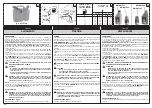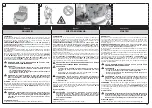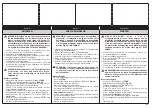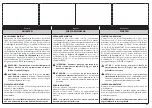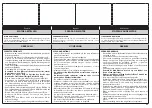
22
29
30
31
32
Italiano
English
Français
AVVIAMENTO
STARTING
MISE EN ROUTE
AVVIAMENTO MOTORE
Assicurarsi che la leva acceleratore (B, Fig.29) funzioni
correttamente e che il limitatore di accelerazione (C) sia
posizionato al minimo. Caricare il carburatore premendo il
bulbo varie volte (D, Fig.30). Portare l’interruttore (A, Fig.29)
in posizione START. Portare la leva starter (E, Fig.31) in
posizione “CLOSE”. Appoggiare il soffiatore sul terreno in
posizione stabile. Tenendo fermo il soffiatore (Fig.32), tirare
energicamente la funicella d’avviamento alcune volte fino ad
ottenere l’avviamento. Aspettare 10 secondi e quindi
azionare la leva acceleratore (B, Fig.29) per sbloccare il
dispositivo di starter automatico. La leva starter (E, Fig.31)
deve ritornare nella posizione originale “OPEN”.
ATTENZIONE! – Quando il motore è già caldo,
non usare lo starter automatico (E, Fig.31) per
l’avviamento.
ATTENZIONE: Si raccomanda di non avviare mai la
macchina senza la girante. Ciò può causare danni
importanti alle parti del motore e l’immediato
decadimento della garanzia.
RODAGGIO MOTORE
Il motore raggiunge la sua massima potenza dopo le prime
5÷8 ore di lavoro.
Durante questo periodo di rodaggio non fare funzionare
il motore a vuoto al massimo numero di giri per evitare
eccessive sollecitazioni.
NOTA: è normale che un motore nuovo emetta fumo
durante e dopo il primo utilizzo.
STARTING THE ENGINE
Check that the throttle trigger (B, Fig.29) functions correctly
and the throttle limiter (C) is set to the minimum position.
Prime the carburettor by pressing the priming bulb a few
times (D, Fig.30). Position the switch (A, Fig.29) on START.
Turn the starter lever (E, Fig.31) to the “CLOSE” position. Rest
the blower on the ground in a stable position. While holding
the blower firmly (Fig.32), pull the starting cord hard a few
times until the engine starts. Wait 10 seconds and then
press the throttle trigger (B, Fig.29) to release the automatic
starter. The starter lever (E, Fig.31) should return to its
original “OPEN” position.
WARNING! – When starting the blower with the
engine already hot, do not use the automatic starter
(E, Fig.31).
WARNING: Never start the blower without the
impeller fitted. This could cause serious damage to the
engine and would lead to the immediate invalidation of
the warranty.
BREAKING-IN THE ENGINE
The engine reaches maximum power after the first 5-8 hours
of activity.
During this period of breaking-in do not use the engine
at wide open throttle without load, to avoid excessive
functioning stress.
NOTE: It is normal for smoke to be emitted from a new
engine during and after first use.
DÉMARRAGE MOTEUR
S’assurer que le levier de l’accélérateur (B, Fig.29) fonctionne
correctement et que la limiteur d’accélération (C) se trouve
positionnée sur le minimum. Charger le carburateur en
pressant plusieurs fois la boule (D, Fig.30). Mettre
l’interrupteur (A, Fig.29) en position START. Mettre le levier
du starter (E, Fig.31) en position “CLOSE”. Appuyer le souffleur
sur le terrain en position stable. En tenant fermement le
souffleur (Fig.32), tirer énergiquement le cordon de
lancement et ce de façon répétée jusqu’à ce qu’il démarre.
Attendre 10 secondes et actionner ensuite le levier de
l’accélérateur (B, Fig.29) pour débloquer le dispositif du
starter automatique. Le levier du starter (E, Fig.31) doit alors
retourner dans sa position initiale “OPEN”.
ATTENTION! – Ne pas utiliser le starter automatique
lorsque le moteur est encore chaud (E, Fig.31) pour
le démarrage.
ATTENTION: On veillera à ne jamais démarrer
l’appareil sans le dispositif mobile. Ceci pourrait
entraîner des dommages importants aux composants
du moteur et l’exclusion immédiate de la garantie.
RODAGE MOTEUR
Le moteur atteint sa puissance maximale au bout des 5÷8
premières heures de travail.
Au cours de cette période de rodage, ne faites pas tourner le
moteur à vide au régime maxi pour lui éviter excessif efforts
de fonctionnement.
REMARQUE : il est normal qu'un moteur neuf dégage de
la fumée durant et après la première utilisation.











